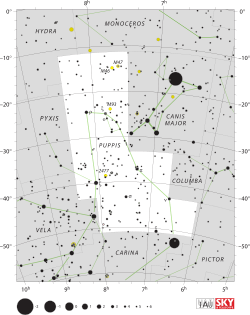Omicron Puppis

|
| Observation data Epoch J2000.0 Equinox J2000.0 | |
|---|---|
| Constellation | Puppis |
| Right ascension | 07h 48m 05.17s |
| Declination | −25° 56' 13.8" |
| Apparent magnitude (V) | +4.40 |
| Distance | 2470 ly (757 pc) |
| Spectral type | B1IV |
| Other designations | |
Omicron Puppis (Omicron Pup, ο Puppis, ο Pup) is multiple star system in constellation of Puppis, with an apparent magnitude of +4.40. The primary component is a blue B-type subgiant. It is approximately 2470 light years from Earth.
Lacaille assigned one Greek letter sequence to the three constellations (Carina, Puppis, and Vela) he created from Argo Navis, and Omicron Puppis is not Lacaille's Omicron Argus (which is now Omicron Velorum). Lacaille assigned Latin lower case 'o' to this star in Puppis, and later astronomers misread this as omicron.[1]
Omicron Puppis is moving through the Galaxy at a speed of 26.9 km/s relative to the Sun. Its projected Galactic orbit carries it between 24,800 and 32,000 light years from the center of the Galaxy.[2]
Omicron Puppis came closest to the Sun 8.7 million years ago when it had brightened to magnitude 3.99 from a distance of 1,162 light years.[2]
Naming
In Chinese, 弧矢 (Hú Shǐ), meaning Bow and Arrow,[3] refers to an asterism consisting of ο Puppis, δ Canis Majoris, η Canis Majoris, HD 63032, HD 65456, k Puppis, ε Canis Majoris, κ Canis Majoris and π Puppis. Consequently, ο Puppis itself is known as 弧矢五 (Hú Shǐ wǔ, English: the Fifth Star of Bow and Arrow.)[4]
References
- ↑ Wagman, Morton (2003). Lost Stars. McDonald and Woodward. p. 259. ISBN 0-939923-78-5.
- 1 2 Omicron Puppis (HIP 38070)
- ↑ 弧矢 (Hú Shǐ) is westernized into Koo She. R.H. Allen had opinion that Koo She refers to the asterism including δ Velorum and ω Velorum. AEEA opinion is, δ Velorum is member of 天社 (Tiān Shè), meaning Celestial Earth God's Temple asterism and ω Velorum is not member of any asterisms. 天社 (Tiān Shè) is westernized into Tseen She and R.H.Allen used the term Tseen She for Chinese name of η Carinae. See Richard Hinckley Allen: Star Names — Their Lore and Meaning: Argo Navis and (Chinese) AEEA (Activities of Exhibition and Education in Astronomy) 天文教育資訊網 2006 年 7 月 17 日.
- ↑ (Chinese) AEEA (Activities of Exhibition and Education in Astronomy) 天文教育資訊網 2006 年 7 月 17 日